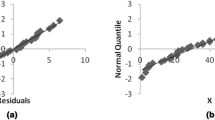Abstract
In the linear regression model, the errors are usually assumed to be uncorrelated. However, in real-life data, this assumption is not often plausible. In this study, first, we will assume that the errors of the regression model have autoregressive structure. This type of regression models has been considered before. However, in those papers under this assumption usually, the symmetric distributions are used as error distribution. The main contribution of this work is to use skew distributions instead of symmetric distributions as error distribution in regression models with autoregressive errors. We provide expectation maximization algorithm to compute the maximum likelihood estimates for the parameters. The performances of the proposed estimators are demonstrated with a simulation study and a real data example. We also provide the confidence intervals using the observed Fisher information matrix for the corresponding estimators.


Similar content being viewed by others
References
Alpuim T, El-Shaarawi A (2008) On the efficiency of regression analysis with AR(p) errors. J Appl Stat 35(7):717–737
Anderson RL (1954) The problem of autocorrelation in regression analysis. J Am Stat Assoc 49(265):113–129
Ansley CF (1979) An algorithm for the exact likelihood of a mixed autoregressive-moving average process. Biometrika 66(1):59–65
Azzalini A (1985) A class of distributions which includes the normal ones. Scand J Stat 12(2):171–178
Azzalini A (1986) Further results on a class of distributions, which includes the normal ones. Statistica 46(2):199–208
Azzalini A (2005) The skew-normal distribution and related multivariate families (with discussion). Scand J Stat 32(2):159–188
Azzalini A (2017) The R package ‘sn’: The skew-normal and skew-t distributions (version 1.5-0). http://azzalini.stat.unipd.it/SN. Accessed 20 Feb 2018
Azzalini A, Capitanio A (2003) Distributions generated by perturbation symmetry with emphasis on a multivariate skew t distribution. J R Stat Soc Ser B (Stat Methodol) 65(2):367–389
Azzalini A, Capitanio A (2014) The skew-normal and related families. IMS monographs. Cambridge University Press, Cambridge, p 270
Beach CM, Mackinnon JG (1978) A maximum likelihood procedure for regression with autocorrelated errors. Econometrica 46(1):51–58
Branco MD, Dey DK (2001) A general class of multivariate skew-elliptical distributions. J Multivar Anal 79(1):99–113
Cochrane D, Orcutt GH (1949) Application of least regression to relationships containing autocorrelated error terms. J Am Stat Assoc 44(245):32–61
Durbin J (1960) Estimation of parameters in time-series regression models. J R Stat Soc Ser B (Methodol) 22(1):139–153
Genton MG (2004) Skew-elliptical distributions and their applications: a journey beyond normality. Chapman & Hall, Boca Raton
Gupta AK, Chang FC, Huang WJ (2002) Some skew symmetric models. Random Oper Stoch Equ 10:133–140
Henze N (1986) A probabilistic representation of the skew-normal distribution. Scand J Stat 13(4):271–275
Lange KL, Little RJ, Taylor JM (1989) Robust statistical modeling using the t distribution. J Am Stat Assoc 84(408):881–896
Lin TI, Lee JC, Hsieh WJ (2007) Robust mixture modeling using the skew t distribution. Stat Comput 17(2):81–92
Olaomi JO, Ifederu A (2008) Understanding estimators of linear regression model with AR(1) error which are correlated with exponential regressor. Asian J Math Stat 1(1):14–23
R Core Team (2017) R: a language and environment for statistical computing. R Foundation for Statistical Computing, Vienna. https://www.R-project.org/. Accessed 5 Jan 2018
Tiku ML, Wong W, Bian G (1999) Estimating parameters in autoregressive models in nonnormal situations: symmetric innovations. Commun Stat Theory Methods 28(2):315–341
Tuaç Y, Güney Y, Şenoğlu B, Arslan O (2018) Robust parameter estimation of regression model with AR (p) error terms. Commun Stat Simul Comput 47(8):2343–2359
Wong W, Bian G (2005) Estimating parameters in autoregressive models with asymmetric innovations. Stat Probab Lett 71(1):61–70
Acknowledgements
The authors thank the anonymous referee, the editor and the associate editor for their careful reading, suggestions and encouragement about this paper.
Author information
Authors and Affiliations
Corresponding author
Ethics declarations
Conflict of interest
All authors declare that they have no conflict of interest.
Human and animals rights
This article does not contain any studies with human participants or animals performed by any of the authors.
Additional information
Communicated by V. Loia.
Publisher’s Note
Springer Nature remains neutral with regard to jurisdictional claims in published maps and institutional affiliations.
Appendices
Appendix A: Skew-normal distribution
In “Appendix A” and “Appendix B,” we give the partial second derivatives of the conditional complete likelihood function with respect to the unknown parameters to obtain the observed Fisher information matrix for the regression model defined in Eq. (4) with both skew-normal and skew-t distributed error terms. Note that the observed Fisher information matrices are used to compute the standard errors and the confidence intervals in the simulation study and the real data examples.
Here \( \eta_{t} = \frac{{\left( {\phi \left( B \right)y_{t} - \phi \left( B \right)x_{t}^{T}\varvec{\beta}} \right)}}{\sigma }, \)\( w_{t} = \frac{{\phi \left( {\lambda \eta_{t} } \right)}}{{\varPhi \left( {\lambda \eta_{t} } \right)}}, \)\( i,r = 1,2, \ldots ,p \) and \( j,k = 1,2, \ldots ,M. \)
Appendix B: Skew-t distribution
Here \( \eta_{t} = \frac{{\left( {\phi \left( B \right)y_{t} - \phi \left( B \right)x_{t}^{T}\varvec{\beta}} \right)}}{\sigma } \), \( w_{t} = \frac{\nu + 1}{{\nu + \eta_{t}^{2} }} \), \( \gamma_{t} = \frac{\nu }{\nu + 1}\frac{{t_{\nu + 1} \left( {\lambda \eta_{t} \sqrt {w_{t} } } \right) }}{{T_{\nu + 1} \left( {\lambda \eta_{t} \sqrt {w_{t} } } \right)}} \), \( i,r = 1,2, \ldots ,p \), \( j,k = 1,2, \ldots ,M, \)\( \alpha_{t} = \frac{2}{\sigma }w_{t} \frac{{\eta_{t} }}{{\nu + \eta_{t}^{2} }} \), \( \psi_{1,t} = \frac{{\lambda^{2} }}{\sigma }\frac{{\nu \left( {\nu + 3} \right)}}{{\left( {\nu + 1} \right)}}w_{t}^{2} \eta_{t} \frac{{\gamma_{t} }}{{\left( {\nu + 1 + \lambda^{2} \eta_{t}^{2} w_{t} } \right)}} - \frac{\lambda }{\sigma }\frac{{\left( {\nu + 1} \right)}}{\nu }w_{t}^{3/2} \gamma_{t}^{2}, \) and \( \psi_{2,t} = - \lambda \left( {\nu + 3} \right)w_{t} \eta_{t}^{2} \frac{{\gamma_{t} }}{{\left( {\nu + 1 + \lambda^{2} \eta_{t}^{2} w_{t} } \right)}} - \frac{{\left( {\nu + 1} \right)}}{\nu }w_{t}^{1/2} \gamma_{t}^{2} \eta_{t} \).
Rights and permissions
About this article
Cite this article
Tuaç, Y., Güney, Y. & Arslan, O. Parameter estimation of regression model with AR(p) error terms based on skew distributions with EM algorithm. Soft Comput 24, 3309–3330 (2020). https://doi.org/10.1007/s00500-019-04089-x
Published:
Issue Date:
DOI: https://doi.org/10.1007/s00500-019-04089-x




